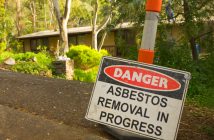Australia’s National Asbestos Awareness Week holds valuable lessons for local companies and workers.
National Asbestos Awareness Week is 21–25 November and aims to raise awareness of asbestos, and where asbestos materials could be found within the work or home space.
Before conducting any construction work, it is important to know what asbestos is, as well as how to manage, control and remove it safely.
“Being asbestos aware is critical to complying with your duties under the model WHS Regulations,” says Dr Paul Taylor, director of occupational hygiene at Safe Work Australia.
“Identifying asbestos and managing the risks of exposure in the workplace will ensure that workers – and others including workers’ families – are protected from the adverse effects of asbestos exposure.”
Taylor stresses that if anyone isn’t sure whether something is an asbestos containing material, assume it is until it is confirmed by an expert and if it needs to be removed, engage a licensed asbestos removalist.
He suggested that identified asbestos be labelled and watched closely for signs of wear and tear.
Taylor also emphasised the importance of keeping an asbestos register for a workplace. “You must keep it up to date and store it in an accessible place,” he explains. “Make sure your workers look at the register before working on anything that might contain asbestos.”
A number of activities will be held across the country to raise awareness of safety when it comes to asbestos, which was once used in Australia in more than 3000 different products including fibro, flue pipes, drains, roofs, gutters, brakes, clutches and gaskets.
Asbestos becomes a health risk when its fibres are released into the air and breathed in, which can in turn cause asbestosis, lung cancer and mesothelioma.
New Zealand’s regulations concerning working with asbestos changed on 4 April this year, reflecting the fact that the material is the country’s number one killer in the workplace.
Around 170 people a year die from asbestos-related diseases, reinforcing the need for the revised Asbestos Regulations 2016.
The regulations introduced a licensing system for removing asbestos while also clarifying the duties for businesses and workers.
More recently, WorkSafe released guidance for managing and removing asbestos in the workplace, the first of its kind in New Zealand.
The Approved Code of Practice for the Management and Removal of Asbestos aims to help contribute to WorkSafe’s target of a 50 per cent reduction in asbestos-related disease by 2040.
Designed for the web so that it can be used on the go, the code was developed in consultation with unions, employer organisations, other key stakeholders and the public.
Previous asbestos guidance focused only on asbestos removal, while this code is applicable to a more comprehensive range of people who are exposed to asbestos.
The code sets out WorkSafe’s expectations for working safely with asbestos and is designed for businesses that manage or control workplaces, carry out asbestos removal, or asbestos-related work, and licensed asbestos assessors. The code applies to landlords too, but not to home occupants doing DIY.
Included is information and guidance on keeping safe around asbestos, like the types of work allowed when working with asbestos, how to identify and manage asbestos and asbestos-containing material in the workplace, prohibited and restricted tools and equipment, personal protective equipment and health monitoring.




